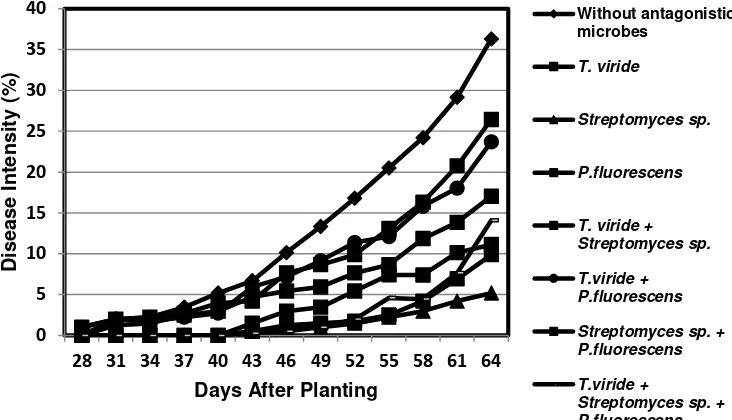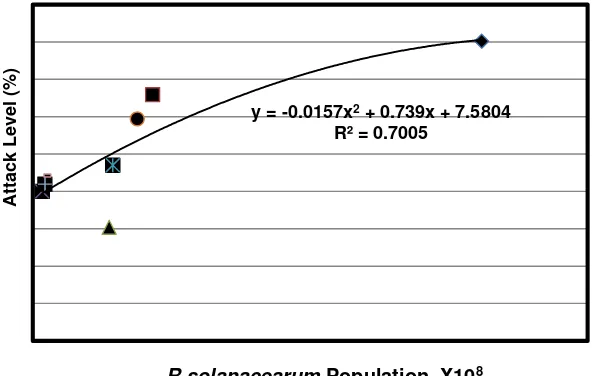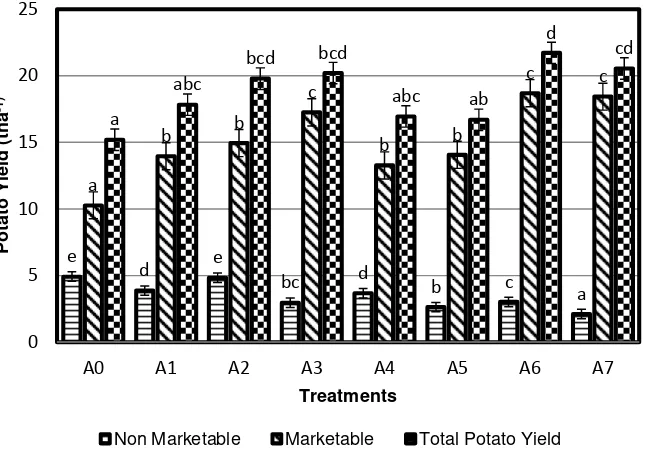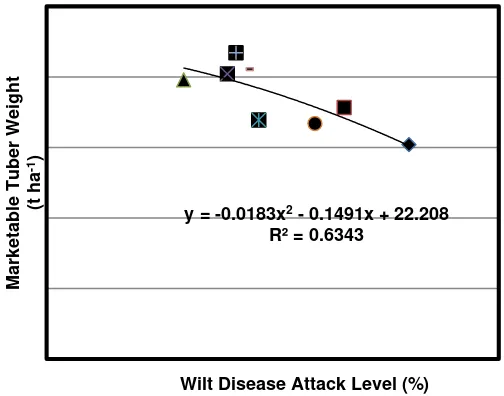ENHANCEMENT IN EFFECTIVENESS OF ANTAGONISTIC MICROBES BY MEANS OF
MICROBIAL COMBINATION TO CONTROL Ralstonia solanacearum
ON POTATO PLANTED IN MIDDLE LATITUDE
Anis Rosyidah1*) Tatik Wardiyati2), Abdul Latief Abadi2) and M. Dawam Maghfoer2)
1*) Agrotechnology Department Faculty of Agriculture Islamic University Jl.Mayjen Haryono 193 Malang 65144 East Java Indonesia
2) Faculty of Agriculture University of Brawijaya Jl. Veteran, Malang 65145 East Java Indonesia *) Corresponding author Phone:+62-341-551932, 551822 E-mail: [email protected]
Received: February 26, 2013/ Accepted: May 16, 2013
ABSTRACT
One of the common problems hampering the cultivation of potatoes in middle latitude is the presence of bacterium Ralstonia solanacearum commonly known to cause wilt disease, by which crop failure might be caused when serious attack occurs. The objectives of the research were to obtain the application of antagonistic microbes to inhibit the wilt disease caused by R.solanacearum and to increase the growth and yield of potato in middle latitude. The research was conducted from July to October 2012. Antagonistic microbes were used in this research to inhibit the bacterial wilt disease caused by R.solanacearum on potato planted in Bumiaji, Batu. Trichoderma viride, Streptomyces sp. and Pseudomonas fluorescens isolates were selected to be applied as treatments either singly or in combination. Randomized block design was applied on the treatment group with three replications. The results showed that the single application of Pseudomonas fluorescens or combined application of Streptomyces sp. and Trichoderma viride + Streptomyces sp. was capable of extending incubation period 4 to 7 days and reducing disease incidence 44.85% – 50.09%, reducing disease intensity up to 61.23 – 72.77%, reducing the population R.solanacearum up to 7.28 – 97.88%, increasing the number of leaves and the marketable yield as much as 67.96 – 81.98%.
Keywords: control, Ralstonia solanacearum, antagonistic microbes, middle latitude
INTRODUCTION
Potato is one of the crops yields which are potential to be included in food diversification. Potato production in Indonesia was increasing by 5% per annum with the planting area of 60,000 ha in 2006, while it could only cope with 10% national food need or as much as 8.9 million tons per annum (Bisnis Indonesia online, 2008).
The supplies of potatoes mostly come from high lands, while the planting areas in highlands were limited and prone to main environmental problems like landslide, intensive cultivation in highlands which may lead to depleting the natural resources due to low productivity of the land and land degradation. On the other hand, middle land provides more spacious plains giving closer access to market places and consumers. However, potato farming in the middle land is exposed to a serious problem such as bacterial wilt disease caused by R. solanacearum causing to 10 – 100% lost when serious attack occurs (Hanudin, 2012; Rosyidah, 2010; Semangun, 2002).
The use of pesticide to control the bacterial wilt disease caused by R.solanacearum is believed to be effective but costly and polluting. On the contrary, the use of biological agents against R.solanacearum hasbeen reported more effective on tomato, potato, chili and tobacco (Hersanti et al., 2009; Heru, 2006; Nurjanani, 2011). Tricho-derma viride, Pseudomonas fluorescens, and Streptomyces are potential antagonistic microbes in hampering R.solanacearum.
Trichoderma viride is very competitive in using the space and nutrition so that it experiences faster growth compared to its pathogen (Ernawati, 2000). In addition, it also has capability of inhibiting the intensity of the disease, incubation period
Accredited SK No.: 81/DIKTI/Kep/2011
(Soesanto, 2004) and the in vitro growth of R.solanacearum on potatoes as much as 36% to 83.33% (Gunawan, 1995; Hersanti et al., 2009; Tuju, 2004). Streptomyces sp. is capable of producing streptomycin, kanamycin and neomycin antibiotic in great amount. Streptomyces sp. also has good antagonistic capability in term of hampering R. solanacearumin vitro by means of antibiosis and bacteriostatic mechanism (Djatmiko et al., 2007). On chili Streptomyces sp. is able to extend the incubation period up to 10.5 days after inoculation and inhibit the percentage of the disease up to 75% (Khairul, 2006).
Pseudomonas fluorescens is capable of controlling R. solanacearum due to secondary metabolites bringing together the antimicrobial activity against bacteria and pathogenic fungi. Pseudomonas fluorescens also produces siderophore which is capable of inhibiting the growth of pathogens by limiting iron (Fe) uptake from soil (Duijff et al., 1993; Dufy and Defago, 1999), gives beneficial influence to the plant growth as Plant Growth Promoting Rhizobacteria (PGPR), and produces cyanide (Landa et al., 2002). Pseudomonas fluorescens is able to inhibit the growth of R.solanacearum on patchouli (Nasrun et al., 2005) and tobacco (Heru, 2006).
The application of combined biological agents in controlling bacterial wilt disease caused by R. solanacearum is the better approach in biological control. Antagonistic microbial combination is expected to be able to increase the potential of biological agents to the better protection level (Guetsky et al., 2001).
From this research was obtained combination of biological agents which were able to effectively and efficiently control wilt disease by bacterium R. solanacearum on potatoes. Consequently, the expectation of optimal growth of potatoes in middle land will be more visible.
MATERIALS AND METHODS
The experiment was conducted from July to October 2012 in endemic wilt disease land in Bumiaji, Batu, Indonesia with the latitude of 670 m above sea leveland the soil texture was clay. The cultivar of potatoes used in this research was DTO-28 whose feature fits the condition of middle land (Wardiyati, 1990). The antagonistic microbes Trichoderma viride, Streptomyces sp., and Pseudomonas fluorescens were supplied from the collection of Microbiology Laboratory of
Mathematics and Science Faculty and Plant Pathology Laboratory of Agriculture Faculty of Brawijaya University, Malang. These microbes were previously selected and tested in vitro in Plant Pathology laboratory of Agriculture Faculty of Brawijaya University to find out antagonistic potential against R. solanacearum pathogen.
Preparing Antagonistic Microbes
Trichoderma viride was grown on Potato Dextrose Agar (PDA), while Streptomyces sp., and Pseudomonas fluorescens were separately grown on Kings B medium for 48 hours in the temperature of 30o C. When the pure cultures were obtained, each culture of Trichoderma viride and Streptomyces sp. was grown on Potato Dextrose Broth (PDB) media, while the pure culture of Pseudomonas fluorescens was grown on Nutrient Broth (NB) by shaking for 24 hours. The available cultures were then suspended to obtain approximately the concentration of 108 cfu.mL-1 for Streptomyces sp. and Pseudomonas fluorescens (Nurbaya et al., 2011) and 107 spora.mL-1 for Trichoderma viride.
Experimental Implementation
The experiment was conducted by applying Randomized Block Design (RBD) with 8 treatments and 3 replications. The treatments tested involved: A0= control (without antagonistic microbes), A1= Trichoderma viride, A2= Strep-tomyces sp., A3= Pseudomonas fluorescens, A4= Trichoderma viride + Streptomyces sp., A5= Tri-choderma viride + Pseudomonas fluorescens, A6= Streptomyces sp.+ Pseudomonas fluorescens dan A7= Trichoderma viride + Streptomyces sp.+ Pseudomonas fluorescens. The 25 ml antagonistic microbe was applied by dousing it into the planting media 2 weeks before planting together with organic matter from chicken manure (Rosyidah, 2010), followed by the second application given at 14 days after planting (dap). There were 27 plants per plot with space of 25 x 70 cm between plants.
The organic matter from manure was given at 15 t.ha-1, while urea 300 kg.ha-1, SP-36 200 kg.ha-1and KCl 300 kg.ha-1 were given as inorganic fertilizers. The plants were intensively taken care of and watered by using watering pot.
were calculated based on the following formula (Sinaga, 2006):
KP = n/N x 100% KP = disease (%)
n = number of wilting plants N = number of plants observed
The development of disease intensity was formulated by using Winstead and Kelman (1952):
IP= a1 n1 +a2 n2 +an nn
5 x total number of plants x 100% Remarks:
IP = Disease intensity a = scoring value per plant
n = plant number with certain scoring value
5 = wilt level : 0 : healthy plant
1 : one wilting leaf or two 2 : 3 to 10 wilting leaves 3 : more than 10 wilting leaves 4 : all leaves wilting
5 : dead
The growth component observed was number of leaves, while the potato yield harvested was observed in yield component.
Data Analysis
The data was analyzed by using analysis of variance (ANOVA), where LSD test at 5% followed when significant influence was present. Statistical analysis (regression and correlation) was done by using Microsoft Excel.
RESULTS AND DISCUSION
Wilt Disease Incidence by R. solanacearum
The emergence of wilt disease by R. solanacearum on potato in the research land brought various results. The selected isolates Trichoderma viride, Streptomyces sp. and Pseudomonas fluorescens given either singly or in combination were proven effective in inhibiting the development of wilt disease by R. solanacearum.
Generally, the application of Pseudomonas fuorescens given singly or combined with
Streptomyces sp., or combined with Trichoderma viride + Streptomyces sp. was capable of extending the incubation period up to 4 – 7 days compared with the treatment without the presence of antagonistic microbes (Figure 1).
It can be concluded that the symptoms caused by R. solanacearum were observable from 45 to 53 days after planting (Figure 1). Hersanti (2009) stated that the incubation period of this disease would depend on its virulence capacity to the host plants with the incubation period ranging from 36 to 49 days. Such an incubation period was affected by several factors: host plant, environment and pathogen. The immunity of plants plays a role in determining the period required by the symptom of bacterial wilt disease caused by R. solanacearum to emergence (Samanhudi, 2009).
The incubation period is positively correlated with the occurring disease incidence (Sastra, 2009). The research results indicated that the single application of antagonistic microbe Streptomyces sp. and Pseudomonas fluorescens was capable of effectively controlling pathogenic attack of R. solanacearum so that the disease incidence was hampered to low (Figure 2). This low disease intensity occurred due to the application of Streptomyces sp. and combination of Streptomyces sp. + Pseudomonas fluorescens (Figure 3).
Figure 1. Incubation period of bacterial wilt disease in various treatments with application of antagonistic microbes. A0= control A1= Trichoderma viride, A2= Streptomyces sp., A3= Pseudomonas fluorescens, A4= Trichoderma viride + Streptomyces sp., A5= Trichoderma viride + Pseudomonas fluorescens, A6= Streptomyces sp.+ Pseudomonas fluorescens dan A7= Trichoderma viride + Streptomyces sp.+ Pseudomonas fluorescens
Figure 2. The disease incidence of wilt disease R. solanacearum at certain ages of plant
a
ab bc
abc
a
a
c c
40.00 42.00 44.00 46.00 48.00 50.00 52.00 54.00 56.00
A0 A1 A2 A3 A4 A5 A6 A7
In
c
ub
a
tio
n
Pe
riod
(Day
s
)
Treatments
0 2 4 6 8 10 12 14 16 18
31 34 37 40 43 46 49 52 55 58 61 64
Disia
se
Incid
ence
(%
)
Days After Planting
Without antagonistic microbes
T. viride
Streptomyces sp.
P.fluorescens
T. viride + Streptomyces sp.
T.viride + P.fluorescens
Streptomyces sp. + P.fluorescens
T.viride +
The ability of Pseudomonas fluorescens to reduce the attack level and intensity was believed to be correlated with its various mechanisms. Pseudomonas fluorescens was said to be able to produce secondary metabolites such as siderophore, pterin, phyrole and phenazine. Siderophore can serve as fungistatic and bacteriostatic agents (Soesanto et al., 2008) and improve the systematic immunity of the plant by increasing the phenol (Park et al., 2009). The ability of Pseudomonas fluorescens to inhibit the population of pathogen was associated with its ability to protect the roots from the infection caused by pathogenic R.solanacearum by colonising the surface of the roots and competing with pathogen in infiltration of cation Fe.
Pseudomonas fluorescens provides secondary metabolites such as pyoverdin and pseudobactin functioning as siderophore (Baharudin et al., 2005). The siderophore developed rapidly covering the roots of plants and translocated Fe in the root zone.
Consequently, this condition supported the root growth, while, at the same time, the absence of ion Fe would hamper the growth of pathogen. The absence of pathogen caused the pathogenic infection on the plant to decrease, which also led
to the lack of R. solanacearum population (Table 1). The close correlation between R. solana-cearum population and the attack level of wilt disease indicated that there was polynomial increase of R. solanacearum population with the increase of wilt disease attack level resulting from the increasing population of R. solanacearum (Figure 4), which is in line with the research conducted by Soesanto et al. (2011) and Hasanah et al. (2013).
Potato Yield and Growth
The potato plant treated with the application of Trichoderma viride, Streptomyces sp. and Pseudomonas fluorescens given either singly or in combination gave the various height of plants (41.16-47.39 cm) (Table 2). The application of antagonistic microbe Trichoderma viride caused the plant to grow taller due to the ability of T. viride to stimulate the plant growth by excreting growth hormone such as auxin and cytokine (Glick, 1995).
The plant treated with the application of antagonistic microbes given either singly or in combination was capable of giving a lot more of leaves than that treated with no antagonistic microbes (Table 2). Fewer leaves were caused by the attack of R. solanacearum.
0 5 10 15 20 25 30 35 40
28 31 34 37 40 43 46 49 52 55 58 61 64
Dise
as
e
Int
ensit
y
(
%
)
Days After Planting
Without antagonistic microbes
T. viride
Streptomyces sp.
P.fluorescens
T. viride + Streptomyces sp.
T.viride + P.fluorescens
Streptomyces sp. + P.fluorescens
T.viride +
Streptomyces sp. + P.fluorescens
Tabel 1. Population of antagonistic microbes and R. solanacearum during harvest time
Antagonistic microbe application Antagonistic microbes Antagonistic microbial population (x107)
R. solanacearum
population Without antagonistic microbes
Trichoderma viride Streptomyces sp.
Pseudomonas fluorescens T. viride+Streptomyces sp.
T. viride+P. Fluorescens
Streptomyces sp.+P. Fluorescens
T. viride+Streptomyces sp.+Pf
T. viride
Streptomyces sp. T. viride
P. fluorescens Streptomyces sp. P. fluorescens T. viride
Streptomyces sp. P. fluorescens
2.27 a 5.10 c 4.50 bc 3.80 b 2.10 c 2.84 1.55 c 3.75 3.67 d 3.01 1.67 d 2.43 3.35
2.02x109 c 5.40x108 b 3.45x108 b 4.30x107 a 3.61x108 b
4.71x108 b
5.50x107 a
5.10 x107 a
LSD 5% 0.81 2.16
Remarks: the numbers with the same letters of the same column indicate not significant difference according to LSD at α = 5%
Figure 4. Correlation between R. solanacearum population and attack level
The application of Pseudomonas fluores-cens given either singly or combined with Streptomyces sp. and in combination of Trichoderma viride + Streptomyces sp. was capable of giving more total and marketable weight of tuber than those treated with no antagonistic microbes (Figure 5). More number of leaves indicated the low attack level of wilt disease. More number of leaves in a certain volume would
increase the weight of tubers per plant (Figure 6). The higher the attack of wilt disease means the lower the total weight of marketable yields (Figure 7). This result is linear with the research reported by Rosyidah (2010), where it was stated that the insignificant weight of the yield resulted from the water translocation which was hampered due to the disturbed xylem tissues.
y = -0.0157x2+ 0.739x + 7.5804 R² = 0.7005
A
tta
c
k
L
e
v
e
l
(%
)
Figure 5. Potato yields in harvesting time
Figure 6. Correlation between leaf number per plant and tuber weight per plant e
d e
bc d b c
a a
b b
c
b b
c c
a
abc
bcd bcd
abc ab
d
cd
0 5 10 15 20 25
A0 A1 A2 A3 A4 A5 A6 A7
Pota
to
Yie
ld
(th
a
-1
)
Treatments
Non Marketable Marketable Total Potato Yield
y = -0.5634x2+ 74.085x - 1667.6 R² = 0.8642
Tu
be
r
W
e
ig
ht
Pe
r Pla
nt
(g)
Figure 7. Correlation between wilt disease attack level and marketable tuber weight
Table 2. Height of plant and numbers of leaves in potato 56 days after planting
Antagonistic microbe application
Plant height (cm)
Leaf number
(stem) Without antagonistic microbes
T. viride
Streptomyces sp. P.fluorescens
T. viride+Streptomyces sp. T. viride+P.fluorescens Streptomyces sp.+P.fluorescens T.viride+Streptomyces sp..+Pf
40.72 a 47.39 c 41.99 ab 42.62 ab 41.61 a 41.16 a 42.09 ab 45.27 bc
41.80 a 50.48 ab 50.52 ab 49.20 a 66.9 c 47.98 a 68.40 c 72.97 c LSD 5% 4.16 16.39
Remarks: the numbers with the same letters of the same column indicate not significant difference based on LSD at α = 5%
The increasing yields of potato tuber treated with Pseudomonas fluorescens given either singly or combined with Stretomyces sp. and in combination of Trichoderma viride + Pseudomonas fluorescens could be correlated with the indirect influence of Pseudomonas fluorescens activity in term of producing growth hormone capable of stimulating root growth (Campbell, 1989).
This result is also linear with that reported by Weller (1988) stating that Pseudomonas fluorescents applied on potato seeds was able to increase the potato and redish yields by 5-33% and 60-144%, respectively. Moreover, Arwiyanto (1998)
confirmed that Pseudomonas fluorescens given in tobacco increased the production as much as 88-92%. Streptomyces sp. is capable of enhancing the plant growth and production by dissolving phosphat, nitrogen fixation (Thakuria et al., 2004), stimulating lateral growth of root and producing IAA growth hormone (Vasudevan et al., 2002 ; Vonderwell et al., 2001). Trichoderma sp. applied in potato was proven to be able to hamper the wilt disease by 100% and increase marketable tuber yield by 52.54% (Rosyidah, 2010).
CONCLUSIONS
All antagonistic microbes applied in this research were capable of inhibiting the attack level and the intensity of wilt disease by bacterium R. solanacearum on potato. Antagonistic microbes given singly were not always more effective than those given in combination.
ACKNOWLEDGMENTS
This manuscript is a part of the first authors dissertation for Doctoral Program at University of Brawijaya. Gratitude is addressed to Directorate General of Higher Education, Department of National Education for the support through doctoral scholarship, and to Luqman Qurata Aini, PhD, for mentoring in the betterment of this article writing. y = -0.0183x2- 0.1491x + 22.208
R² = 0.6343
M
a
rke
ta
bl
e
Tu
be
r
We
ig
ht
(t h
a
-1)
Thanks are also expressed to all the staff of bacterium laboratory, Pest and Plant Disease, Brawijaya University .
REFERENCES
Arwiyanto, T. 1998. Biological Control on Wilt Disease due to Bacteria in Tobacco. ( in Indonesia) Integrated Excellent Research Report IV (1996-1998). pp.58
Baharuddin, Nursaba and T. Kuswinanti. 2005. Impacts of giving Pseudomonas fluorescens and Effective Organism in Hampering Wilt Disease Bacterium (Ralstonia solanacearum) in Chilli (Capsi-cum annum L.). ( in Indonesia) Scientific Seminar and Annual Meeting of PEI and PFI XVI Komda South Sulawesi, 2005.ISBN : 979-95025-6-7: 195-200. Bisnis Indonesia Online. 2008. Potato Seed gets
more Costly. (in Indonesia) http://www. w3.org/TR/html (accessed on April 23, 2009)
Campbell, R. 1989. Biological control of microbial plant pathogens.Cambridge University Press. Cambridge. p. 218
Djatmiko, H.A., T. Arwiyanto, T. Hadisutrisno and B.H Sunarminto. 2007. Potential of three Genera of Bacteriafrom Three Crop Rhizospheres as A Biological Control Agent for Lincat Disease.(in Indonesia). J. lmu-Ilmu pertanian Indonesia.vol 9: 40-47 Duffy, B.K. and G. Defago. 1999. Environmental
factor modulating antibiotic and siderophore biosynthesis by Pseudomo-nas fluorescens Strains. App. Env. Microb. 65(6): 2429-2438
Duijff, B.J., J.W. Meijer, P.A.H.M. Bakker and B. Schippers. 1993. Siderophore-mediated competition for iron and induced resistence in the suppression of Fusarium wilt of carnation by Pseudomonas fluorescens. Netherland Journal of Plant Pathology 99: 277-289
Ernawati, N.M. 2003. Potential of antagonistic micro-organism of soil in hampering Pseudomonas solanacearumin in vitro banana in Lombok Island.(in Indonesia) http://tumoutou.net/70207134/nml.ernawat i.htm (accessed on July 12, 2008)
Glick, R.B. 1995. The enhancement of plant growth promotion by free living bacteria. J. Microbiol 41:109-117
Guetsky, R., D. Shtienberg, Y. Elad, and A. Dinoor. 2001. Combining biocontrol agents to reduce the variability of biological control. Phytopathology 91(43): 621-627
Gunawan, O.S., 1995. Effects of antagonistic microbes in controlling wilt disease bacterium Pseudomonas solanacearum in potatoes.(in Indonesia). Treatise of National Congress XIII and Scientific Seminar of PFI. Mataram, September 25-27, 1995. p. 473-479.
Hanudin, B. Marwoto, Hersanti and A. Muharam. 2012. Compatibility of Bacillus subtilis, Pseudomonas fluorescens and Tricho-derma harzianum in controlling Ralstonia solanacearum in potatoes. ( in Indonesia) J.Hortikultura. 22(2): 173-180
Hasanah, F., A. Rosyidah and I. Murwani. 2013. Application of Pseudomonas fluorescens and several organic matters in controlling Ralstonia solanacearum in Potatoes (Solanum tuberosum L.). ( in Indonesia). J. Agronisma. 1(1):1-12
Hersanti, R. T., A. Rupendi, Purnama, Hanudin, B. Marwoto and O. S. Gunawan. 2009. Filtration of some isolates Pseudomonas fluorescens, Bacillus subtilis and Trichoderma harzianum Antagonistic to R. solanacearum in potatoes. ( in Indonesia) J.Agrikultura 20(3): 198-203
Heru. 2006. Study of biological control for lincat disease in tobacco by combining Pseudomonas fluorescens, Bacillus spp., and Streptomyces spp. ( in Indonesia) Dissertation. Postgraduate Program. Gajah Mada University. Yogyakarta (unpublished)
Khairul, U. 2006. Study of Streptomyces sp. utilization as biological control agents for bacterial wilt Ralstonia solanacearum on chili. (in Indonesia). http://repository. unand.ac.id/2005/
Landa, B.B., H.A.E de Werd, B.B. Mcspadden Gardener and D.M. Weller. 2002. Comparison of three methods for monitoring populations of different genotypes of 2,4-diacethylphloroglucinol-producing Pseudomonas fluorescens in rhizosphere. Phytopathology 92: 129-137 Nasrun, Christanti, T. Arwiyantoand I. Mariska.
fluorescens. (in Indonesia) J. Penelitian Tanaman Industri. 11(1): 19-24
Nurbaya., M, D. Rahim, T. Kuswinanti and Baharuddin.2011. Combined effect of isolate antagonistic bacteria to bacterial wilt disease (Ralstonia solanacearum) raising the potato crop aeroponics (in Indonesia). http://www.peipfi-komdasulsel. org. (accessed on July 19, 2011)
Nurjajani. 2011. Study of biological control agents in wilt disease bacterium (Ralstonia solanacearum). (in Indonesia). Suara Perlindungan Tanaman.1(4):1-8
Park, K.H., C.Y. Lee, and H.J. Son. 2009. Mechanism of insoluble phosphate solubilization by Pseudomonas fluores-cens RAF15 isolated from ginseng rhizos-phere and its plant growth promoting activities. Letters in Applied Microbiology 49: 222–228.
Rosyidah, A. 2010. Effects of organic matters and application time of biological agent Trichoderma sp. on potato yields in Middle Latittudes.(in Indonesia).Thesis. Postgra-duate Program of Brawijaya University. Malang. pp 76. Uplibished.
Samanhudi. 2009. Screening on endurance of potato clone to bacterial wilt disease. ( in Indonesia). Agriculture Faculty of Sebelas Maret University. http://pertanian.uns. ac.id (accessed on June 16, 2009)
Sastra, D.R. 2009. Incubation period of pathogenic bacterium Ralstonia solanacearum RAS 3 in several potato clones. (in Indonesia) J. Agronomi. 8(1):63-67
Shimizu. 2002. Studies on endophyti cactino-mycetes (I) Streptomyces sp. isolated from rhododendron and its antifungal activity. General Plant Pathology. 66:3 60-366 Sinaga, M.S.2006. Basics of plant pathology .(in
Indonesia). Penebar Swadaya. Jakarta. pp.136
Soesanto, L. 2004. Ability of P. fluorescens P60 as a biological control agent for rot disease on stems of in vivo peanuts.( in Indonesia) Eugenia. 10(1):8-17
Soesanto, L., Rokhlani and N. Prihatiningsih. 2008. Hampering microorganims anta-gonistic to fusarium wilt disease in gladioli. (in Indonesia). J. Agrivita. 30(1): 75-83 Soesanto, L., E. Mugiastuti and R.F. Rahayuniati.
2011. Inventory and identification of soil-borne pathogens in potato planting in Purbalingga Regency.(in Indonesia) J. Hort. 21(3): 254-264
Semangun, H. 2002. Horticultural diseases in Indonesia. (in Indonesia) Gajah Mada Press.Yogyakarta. pp.850.
Thakuria D, Talukdar NC, Goswani C, Hazarika S, Boro RC. 2004. Characterization and screening of bacteria from rhizosphere of rice grown in acidic soils of assam. Current Science 83: 1140-1143.
Tuju, M.J. 2004. Test of antagonisme Trichoderma spp. to R. Solanacearum cause wilt bacteria disease in potato plant. Eugenia 10(2): 143-155
Vasudevan, P. M.S. Reddy, S. Kavitha, P. Velusamy and R.S.D. Paulraj. 2002. Role of biological preparations in enhancement of rice seedling growth and grain yield. Current Science 83: 1140-1143.
Vonderwell, J.D., S.A. Enebak and L.J. Samuelson. 2001. Influence of two plant gowth-promoting rhizobacteria on loblolly pine root respiration and IAA activity. Forest science. 47:197-202.
Wardiyati, T. 1990.Effect of high temperature on the formation of potato (Solanum tuberosum L.) tubers in the lowlands. Disertation. Postgraduate Program Bogor Agricultural University. pp 108
Weller, D.M. 1988. Biological control of soil-borne plant pathogens in the rhizospher with bacteria. Ann. Rev. Phytopathol 26:379-407




